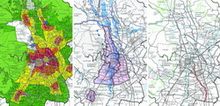Chiang Mai Comprehensive Plan: Between Interpretation and Standardized Procedure
Main Article Content
Abstract
The draft version of the Chiang Mai Comprehensive Plan, 4th Revision, had been processed through the first public hearing in February 2022. It was among the first entries following the Urban Planning Act 2019. There were various challenging aspects relevant to the new planning standard activation, especially the newly introduced “Resource Plan” and “Water Plan”. These new plans need to be in concurrence with other conventional plans, namely “Land Use Plan”, “Open Space Plan”, “Transport Plan” and “Facility Plan”. The objectives of this article are: 1) to initiate a case study of the Chiang Mai Comprehensive Plan for discussion on the standardized procedure of the planner and interpretation from the stakeholder’s point of view and problem identification; 2) to analyse the concurrence/contrast of each plan with the significant content as imprinted on the newly introduced plans (also known as “Resource Plan” and “Water Plan”); and 3) to conclude the initial response from the planner regarding the challenging aspects on the making of Chiang Mai Comprehensive Plan. The content analysis of the drafted Chiang Mai Comprehensive Plan revealed that details on safety, health and welfare should be established precisely to serve its purpose. However, components such as public parks, sport venues and local crematoriums were deliberately missed out from the plans. Public transportation system, which is needed to guide the direction of future development, was also a significant missing piece and did not take into consideration land use and density allowance. Misinterpretation of housing trends, from both private and public sectors, as well as other land use categories, such as governmental and agricultural land uses, together with the inadequate “Resource Plan” and discoursed “Water Plan” has challenged the planners significantly. The concluding comments argue in favour of tipping the balance between personal gains and sacrifices for the common good, despite inevitable facts reflected in the plans, which were mutually connected and provisioned by the new Act. Accordingly, the planners reflected on the following challenges: 1) Even with a better standardized procedure, the stakeholders were still targeting on the winning or losing of their right to develop and only questioning on the details of “Land Use Plan” and “Transport Plan”, without much consideration on the city’s potential and limitation; 2) Most stakeholders either misunderstood or defend their right to agree with the draft version of plans during their first public hearing. As a result, their silence could rebound and result into many unwanted changes in response to those who officially voiced their objection; and 3) Regarding urban conservation, lacks of legal measurement initiated at the local government level could be considered as inaction and thus no leverage could be applied for stricter or advanced urban planning regulations to protect the historic quarters of the city.
Downloads
Article Details

This work is licensed under a Creative Commons Attribution-NonCommercial-NoDerivatives 4.0 International License.
References
Bunnaroth Buaklee. Banthưk botrīan čhāk pā wǣng khwāmphit phlāt khō̜ng phāk rat thī mai klā yō̜m rapphit [Lesson Learned from “Deforestation Housing” A Mistake that the State Does Not Dare to Accept]. Accessed June 29, 2022. Available from https://www.bangkokbiznews.com/lifestyle/1002437
Chayapon Tongsawat. Sī pī thī rō̜ khō̜i khō̜ ngō̜bān pā wǣng rō̜i dāng khō̜ng phāk rat kap chai chana khō̜ng prachāchon thī yang mai čhop [Four Years of Endurance on “Deforestation Housing”, The Stain of State and Unfinished Victory of People]. Accessed June 29, 2022. Available from https://themomentum.co/feature-doi-suthep/
Department of Town and Country Planning. (Rāng) Phangmư̄ang rūam mư̄ang Chīang Mai chabap prap prung khrang thī 4 [The Draft Version of Chiang Mai Comprehensive Plan, 4th Revision]. Accessed June 29, 2022. Available from https://web.facebook.com/Chiangmaiplan/?_rdc=1&_rdr
ICOMOS and IUCN. Connecting Practice, Phrase III Final Report. Accessed June 29, 2022. Available from https://openarchive.icomos.org/id/eprint/2477/7/ConnectingPractice_III_EN.pdf
Khaosod Online. Chīang mai ʻūam Hāng Dong nam thūam nak rō̜p siphā pī chāobān khon khō̜ng nī nampā klāngdưk [Chiang Mai Experiencing Severe Flooding: Hang Dong as The Worst 15-year Flood Made Villagers Flee Flashflood During the Night]. Accessed June 29, 2022. Available from https://www.khaosod.co.th/around-thailand/news_565316
“Khō̜kamnot kīeokap kānčhat san thīdin phư̄a thīyūʻāsai læ phānitchayakam čhangwat Chīang Mai Phō̜.sō̜. sō̜ng phan hārōi hok sip ʻet [Provincial Regulation of Residential and Commercial Land Subdivision in Chiang Mai Province, 2019].” The Royal Thai Government Gazette, Vol. 136, part 11 Ngor (January 11, 2019): 11-26.
“Kot krasūng bang khap chai phangmư̄ang rūam mư̄ang Chīang Mai Phō̜.sō̜. sō̜ng phan hārōi hā sip hā [Ministerial Regulation of Chiang Mai Comprehensive Plan, 2012].” The Royal Thai Government Gazette, Vol. 130, part 43 Kor (May 21, 2013): 1-15.
McGrath, Brian, Somporn Sangawongse, Danai Thaikatoo and Corte, Martina Barcelloni. “The Architecture of the Metacity: Land Use Change, Patch Dynamics and Urban Form in Chiang Mai, Thailand.” Urban Planning 2, 1 (2017): 53–71.
“Phrarātchabanyat kān phangmư̄ang Phō̜.sō̜. sō̜ng phan hārōi hok sip sō̜ng [Urban Planning Act, 2019].” The Royal Thai Government Gazette, Vol. 136, part 71 Kor (May 29, 2019): 27-70.
Sarassawadee Ongsakul. “The Plan of Chiang Mai City: Concepts and Local Knowledge.” Journal of the Siam Society 108, 2 (2020): 47–64.
Supawut Boonmahathanakorn. Lanna Landscape sip phō̜n ron mai phư̄nbān lān nā thī chư̄am samphanthaphāp rawāng khon kap sūan - nā - pā - bān [Lanna Landscape: 10 Native Plants of Lanna Region that Connect People to their Gardens-fields-forests-villages]. Accessed June 29, 2022. Available from https://readthecloud.co/lanna-landscape/
TCIJ Editor. Phœ̄i Chīang Mai mī parimān khaya māk penʻan dap sō̜ng khō̜ng prathēt [Revealing Chiang Mai as The Second Largest Amount of Garbage in Thailand]. Accessed June 29, 2022. Available from https://www.tcijthai.com/news/2020/1/current/9766
Transtimenews. Rō̜. fō̜ mō̜ trīam sāng rotfaifā Chīang Mai pī hoksiphā dai nang pī čhetsip [State Railway of Thailand Prepares to Build Chiang Mai Light Rail Transit System in 2022 Finished in 2027]. Accessed June 29, 2022. Available from https://www.transtimenews.co/7248/
Tus Werayutwattana. Our Journey to Chiang Mai becoming a UNESCO World Heritage City. Accessed June 29, 2022. Available from https://www.chiangmaicitylife.com/clg/our-city/journey-becoming-unesco-world-heritage-city/
Yongtanit Pimonsathean. Kān prapprung fư̄nfū mư̄ang læ kānʻanurak mư̄ang [Urban Conservation and Regeneration]. Bangkok: Thammasat University Press, 2013.


